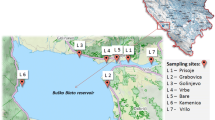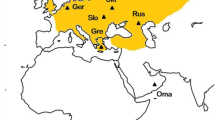Abstract
The variability of the mtDNA control region (D-loop) was examined in Amur sturgeon endemic to the Amur River. This species is also classified as critically endangered by the IUCN Red List of Threatened species. Sequencing of 796- to 812-bp fragments of the D-loop in 112 sturgeon collected in the Lower Amur revealed 73 different genotypes. The sample was characterized by a high level of haplotypic (0.976) and nucleotide (0.0194) diversity. The identified haplotypes split into two well-defined monophyletic groups, BG (n = 39) and SM (n = 34), differing (HKY distance) on average by 3.41% of nucleotide positions with an average level of intragroup differences of 0.54 and 1.23%, respectively. Moreover, the haplotypes of the SM groups differed by the presence of a 13–14 bp deletion. Most of the specimens (66 out of 112) carried BG haplotypes. Overall, the pattern of pairwise nucleotide differences and the results of neutrality tests, as well as the results of tests for compliance with the model of sudden demographic expansion or with the model of exponential growth pointed to a past significant increase in the number of Amur sturgeon, which was most clearly manifested in the analysis of data on the BG haplogroup. The constructed Bayesian skyline plots showed that this growth began about 18-16 thousand years ago. At present, the effective size of the strongly reduced (due to overfishing) population of Amur sturgeon may be equal to or even lower than it was before the beginning of this growth during the Last Glacial Maximum. The presence in the mitochondrial gene pool of Amur sturgeon of two haplogroups, their unequal evolutionary dynamics, and, judging by scanty data, their unequal representation in the Russian and Chinese parts of the Amur River basin point to the possible existence of at least two distinct populations of Amur sturgeon in the past.
Similar content being viewed by others
References
Bemis, W.E., Findeis, E.K., and Grande, L., An overview of Acipenseriformes, Environ. Biol. Fishes, 1997, vol. 48, pp. 25–71.
Ludwig, A., Belfiore, N., and Pitra, C., Genome duplication events and functional reduction of ploidy levels in sturgeon (Acipenser, Huso and Scaphirhynchus), Genetics, 2001, vol. 158, pp. 1203–1215.
Krieger, J., Hett, A.K., Fuerst, P.A., et al., The molecular phylogeny of the order Acipenseriformes revisited, J. Appl. Ichthyol., 2008, vol. 24, suppl. 1, pp. 36–45.
Soldatov, V.K., The study of acipenserids of Amur River, Mater. Poznaniyu Russ. Rybolov., 1915, vol. 3, no. 12, pp. 96–415.
Nikol’skii, G.V., Ryby basseina Amura (Itogi Amurskoi ikhtiologicheskoi ekspeditsii, 1945–1949 gg.) (Fishes of Amur Basin (Results of the Amur Ichthyological Expedition)), Moscow: Akad. Nauk SSSR, 1956.
Omoto, N., Maebayashi, M., Hara, A., et al., Gonadal maturity in wild sturgeons, Huso dauricus, Acipenser mikadoi and A. schrenckii caught near Hokkaido, Japan, Environ. Biol. Fishes, 2004, vol. 70, no. 4, pp. 381–391.
Krykhtin, M.L. and Svirskii, V.G., Endemic sturgeons of the Amur River: kaluga, Huso dauricus, and Amur sturgeon, Acipenser schrenckii, Environ. Biol. Fishes, 1997, vol. 48, pp. 231–239.
Wang, Y. and Chang, J., Status and conservation of sturgeons in Amur River, China: a review based on surveys since the year 2000, J. Appl. Ichthyol., 2006, vol. 22, suppl. 1, pp. 44–52.
Ruban, G. and Qiwei, W., Acipenser schrenckii, in IUCN 2013: IUCN Red List of Threatened Species. Version 2013.2, 2013. http://www.iucnredlist.org. Accessed June 3, 2014.
Vasil’ev, V.P., Vasil’eva, E.D., Shedko, S.V., and Novomodny, G.V., How many times has polyploidization occurred during acipenserid evolution? New data on the karyotypes of sturgeons (Acipenseridae, Actinopterygii) from the Russian Far East, J. Ichthyol., 2010, vol. 50, no. 10, pp. 950–959.
Mugue, N.S., Barmintseva, A.E., Rastorguev, S.M., et al., Polymorphism of the mitochondrial DNA control region in eight sturgeon species and development of a system for DNA-based species identification, Russ. J. Genet., 2008, vol. 44, no. 7, pp. 793–798.
Staden, R., Beal, K.F., and Bonfield, J.K., The Staden package, 1998, Methods Mol. Biol., 2000, vol. 132, pp. 115–130.
Katoh, K., Misawa, K., Kuma, K., and Miyata, T., MAFFT: a novel method for rapid multiple sequence alignment based on fast Fourier transform, Nucleic Acids Res., 2002, vol. 30, pp. 3059–3066.
Villesen, P., FaBox: an online toolbox for fasta sequences, Mol. Ecol. Notes, 2007, vol. 7, no. 6, pp. 965–968.
Excoffier, L. and Lischer, H.E.L., Arlequin suite ver. 3.5: a new series of programs to perform population genetics analyses under Linux and Windows, Mol. Ecol. Res., 2010, vol. 10, no. 3, pp. 564–567.
Swofford, D.L., PAUP*: Phylogenetic Analysis Using Parsimony (*and Other Methods): Version 4, Sunderland: Sinauer Associates, 2002.
Ewens, W.J., The sampling theory of selectively neutral alleles, Theor. Popul. Biol., 1972, vol. 3, no. 1, pp. 87–112.
Watterson, G.A., The homozygosity test of neutrality, Genetics, 1978, vol. 88, no. 2, pp. 405–417.
Tajima, F., Statistical method for testing the neutral mutation hypothesis by DNA polymorphism, Genetics, 1989, vol. 123, no. 3, pp. 585–595.
Fay, J.C. and Wu, C.I., Hitchhiking under positive Darwinian selection, Genetics, 2000, vol. 155, no. 3, pp. 1405–1413.
Fu, Y.X., Statistical tests of neutrality of mutations against population growth, hitchhiking and background selection, Genetics, 1997, vol. 147, no. 2, pp. 915–925.
Kelly, J.K., A test of neutrality based on interlocus associations, Genetics, 1997, vol. 146, no. 3, pp. 1197–1206.
Eckert, A.J., Liechty, J.D., Tearse, B.R., et al., DnaSAM: software to perform neutrality testing for large datasets with complex null models, Mol. Ecol. Res., 2010, vol. 10, pp. 542–545.
Watterson, G.A., The homozygosity test after a change in population size, Genetics, 1986, vol. 112, no. 4, pp. 899–907.
Zeng, K., Fu, Y.-X., Shi, S., and Wu, C.-I., Statistical tests for detecting positive selection by utilizing high-frequency variants, Genetics, 2006, vol. 174, no. 3, pp. 1431–1439.
Rogers, A. and Harpending, H., Population growth makes waves in the distribution of pairwise genetic differences, Mol. Biol. Evol., 1992, vol. 9, no. 3, pp. 552–569.
Schneider, S. and Excoffier, L., Estimation of past demographic parameters from the distribution of pairwise differences when the mutation rates vary among sites: application to human mitochondrial DNA, Genetics, 1999, vol. 152, no. 3, pp. 1079–1089.
Kuhner, M.K., Yamato, J., and Felsenstein, J., Maximum likelihood estimation of population growth rates based on the coalescent, Genetics, 1998, vol. 149, no. 1, pp. 429–434.
Drummond, A., Nicholls, G., Rodrigo, A., and Solomon, W., Estimating mutation parameters, population history and genealogy simultaneously from temporally spaced sequence data, Genetics, 2002, vol. 161, pp. 1307–1320.
Drummond, A.J., Suchard, M.A., Xie, D., and Rambaut, A., Bayesian phylogenetics with BEAUti and the BEAST 1.7, Mol. Biol. Evol., 2012, vol. 29, no. 8, pp. 1969–1973.
Pybus, O.G., Rambaut, A., and Harvey, P.H., An integrated framework for the inference of viral population history from reconstructed genealogies, Genetics, 2000, vol. 155, no. 3, pp. 1429–1437.
Drummond, A.J., Rambaut, A., Shapiro, B., and Pybus, O.G., Bayesian coalescent inference of past population dynamics from molecular sequences, Mol. Biol. Evol., 2005, vol. 22, no. 5, pp. 1185–1192.
Brown, J.R., Beckenbach, A.T., and Smith, M.J., Intraspecific DNA sequence variation of the mitochondrial control region of white sturgeon (Acipenser transmontanus), Mol. Biol. Evol., 1993, vol. 10, no. 2, pp. 326–341.
Wang, W., Hua, Z., Hu, H.-X., et al., Heteroplasmy in mtDNA control region and phylogenetics of five sturgeons, Zool. Res., 2009, vol. 30, no. 5, pp. 487–496.
Raymond, M. and Rousset, F., An exact test for population differentiation, Evolution, 1995, vol. 49, no. 6, pp. 1280–1283.
Excoffier, L., Smouse, P.E., and Quattro, J.M., Analysis of molecular variance inferred from metric distances among DNA haplotypes: application to human mitochondrial DNA restriction data, Genetics, 1992, vol. 131, no. 2, pp. 479–491.
Niu, C.-J., Hu, H.-X., Luo, J., and Li, C., Genetic diversity in the reserved parent fish broodstocks of Asipenser schrenckii and Huso dauricus, J. Fish. China, 2010, vol. 34, no. 12, pp. 1795–1799.
Wang, W., Zhu, H., and Hu, H.-X., Genetic diversity of the reserved broodstocks in four species of sturgeon, Chin. J. Zool., 2012, vol. 47, no. 1, pp. 105–111.
Zhang, S.M., Wang, D.Q., and Zhang, Y.P., Mitochondrial DNA variation, effective female population size and population history of the endangered Chinese sturgeon, Acipenser sinensis, Conserv. Genet., 2003, vol. 4, no. 6, pp. 673–683.
Qiwei, W., Acipenser sinensis, in IUCN 2013: IUCN Red List of Threatened Species. Version 2013.2, 2013. http://www.iucnredlist.org. Accessed June 3, 2014.
Duke, S., Down, T., Ptolemy, J., et al., Acipenser transmontanus, in IUCN 2013: IUCN Red List of Threatened Species. Version 2013.2, 2013. http://www.iucnredlist.org. Accessed June 3, 2014.
Weber, D.S., Stewart, B.S., and Lehman, N., Genetic consequences of a severe population bottleneck in the Guadalupe fur seal (Arctocephalus townsendi), J. Hered., 2004, vol. 95, no. 2, pp. 144–153.
Johnson, J.A., Dunn, P.O., and Bouzat, J.L., Effects of recent population bottlenecks on reconstructing the demographic history of prairie-chickens, Mol. Ecol., 2007, vol. 16, no. 11, pp. 2203–2222.
Wei, Q., Ke, F., Zhang, J., et al., Biology, fisheries and conservation of sturgeons and paddlefish in China, Environ. Biol. Fishes, 1997, vol. 48, pp. 241–255.
Koshelev, V.N., Mikheev, P.B., Litovchenko, Zh.S., et al., Age and growth of the Amur sturgeon (Acipenser schrenckii) from Amur River, Izv. Tikhookean. Inst. Rybov. Okeanogr., 2009, vol. 159, pp. 136–147.
Slatkin, M. and Hudson, R.R., Pairwise comparisons of mitochondrial DNA sequences in stable and exponentially growing populations, Genetics, 1991, vol. 129, no. 2, pp. 555–562.
Marjoram, P. and Donnelly, P., Pairwise comparisons of mitochondrial DNA sequences in subdivided populations and implications for early human evolution, Genetics, 1994, vol. 136, no. 2, pp. 673–683.
Hein, J., Schierup, M.H., and Wiuf, C., Gene Genealogies, Variation and Evolution: A Primer in Coalescent Theory, Oxford Univ. Press, 2005.
Koshelev, V.N., Amur sturgeon, Acipenser schrenckii Brandt, 1869 (distribution, biology, artificial reproduction), Extended Abstract of Cand. Sci. Dissertation, Vseross. Nauchno-Issled. Inst. Rybov. Okeanogr., Moscow, 2010.
Allendorf, F.W., Isolation, gene flow and genetic differentiation among populations, in Genetics and Conservation: A Reference for Managing Wild Plant and Animal Populations, Schonewald, C.M., Chambers, S.M., MacBryde, B., and Thomas, W.L., Eds., New York: Blackburn, 1983, pp. 51–66.
Doukakis, P., Birstein, V.J., Ruban, G.I., and DeSalle, R., Molecular genetic analysis among subspecies of two Eurasian sturgeon species, Acipenser baerii and A. stellatus, Mol. Ecol., 1999, vol. 8, pp. 117–127.
Grunwald, C., Stabile, J., Waldman, J., et al., Population genetics of shortnose sturgeon Acipenser brevirostrum based on mitochondrial DNA control region sequences, Mol. Ecol., 2002, vol. 11, pp. 1885–1898.
Waldman, B.J.R., Grunwald, C., Stabile, J., and Wirgin, I., Impacts of life history and biogeography on the genetic stock structure of Atlantic sturgeon Acipenser oxyrinchus oxyrinchus, gulf sturgeon A. oxyrinchus desotoi, and shortnose sturgeon A. brevirostrum, J. Appl. Ichthyol., 2002, vol. 18, pp. 509–518.
Doukakis, P., Birstein, V.J., and DeSalle, R., Intraspecific structure within three caviar-producing sturgeons (Acipenser gueldenstaedtii, A. stellatus, and Huso huso) based on mitochondrial DNA analysis, J. Appl. Ichthyol., 2005, vol. 21, pp. 457–460.
Bemis, W.E. and Kynard, B., Sturgeon rivers: an introduction to acipenseriform biogeography and life history, Environ. Biol. Fishes, 1997, vol. 48, pp. 167–183.
Lindberg, G.U., Krupnye kolebaniya urovnya okeana v chetvertichnyi period: biogeograficheskie obosnovaniya gipotezy (Large-Scale Fluctuations of Sea Level in the Quaternary Period: Hypothesis Based on Biogeographical Evidence), Leningrad: Nauka, 1972.
Frankham, R., Effective population size/adult population size ratios in wildlife: a review, Genet. Res., 1995, vol. 66, no. 2, pp. 95–107.
Author information
Authors and Affiliations
Corresponding author
Additional information
Original Russian Text © S.V. Shedko, I.L. Miroshnichenko, G.A. Nemkova, V.N. Koshelev, M.B. Shedko, 2015, published in Genetika, 2015, Vol. 51, No. 2, pp. 200–216.
Rights and permissions
About this article
Cite this article
Shedko, S.V., Miroshnichenko, I.L., Nemkova, G.A. et al. Mitochondrial DNA sequence variation, demographic history, and population structure of Amur sturgeon Acipenser schrenckii Brandt, 1869. Russ J Genet 51, 169–184 (2015). https://doi.org/10.1134/S102279541502012X
Received:
Accepted:
Published:
Issue Date:
DOI: https://doi.org/10.1134/S102279541502012X




